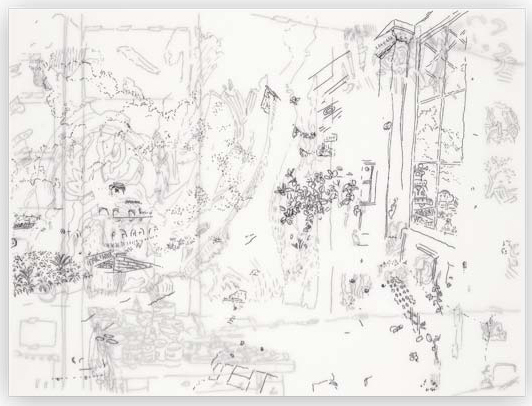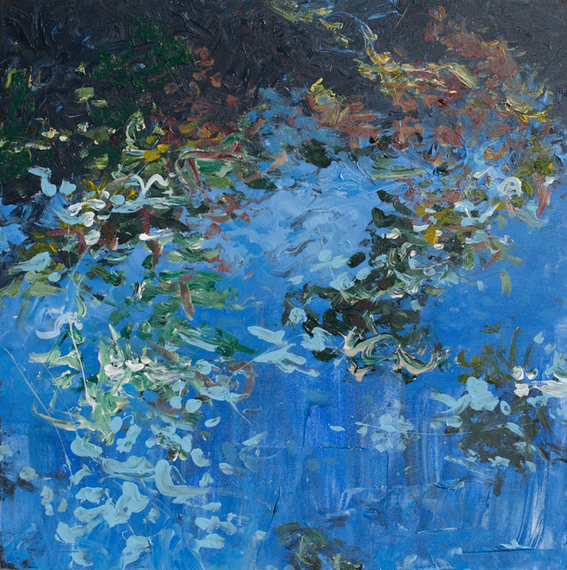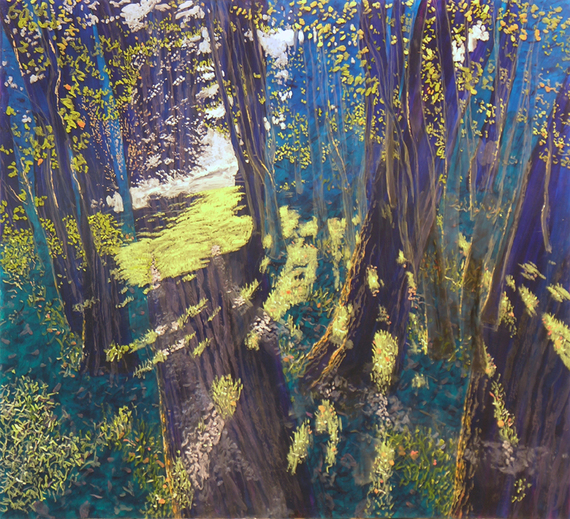It is difficult to pinpoint the exact date the landscape became a primary subject for artists. Wikipedia places the earliest "pure landscape," which is a work of art that has an outdoor setting with no people depicted, sometime around 3,500 years ago in the frescoes of Minoan Greece. For argument's sake, let's say the landscape was and still is an essential part of most any era and its associated arts and culture. The biggest change we are seeing today with the contemporary artist's approach to the landscape is how they relate this time-tested type to some sort of political statement, while other artists see it as a way to express the land's power and beauty. Some see the genre as a springboard for abstraction and fantasy while still others have a more analytical view of nature's subtleties.
The current exhibition at Elga Wimmer PCC Resonance and Memory: The Essence of Landscape features the work of eight contemporary artists who put forth a wide range of 'landscape' possibilities. Kathleen Elliot is a sculptor who works primarily with glass. Her art often falls into the category of fantasy when she offers us her more animated forms of fruit with leaf-like legs, while works from her cyclone series serve as a warning of more severe climate change ahead. What is most remarkable about her work is her sense of pure naturalistic color and the consistency of her vision, characteristics that would work well if Elliot decides to scale up her works for public spaces. Conversely, the fineness and intimacy of her smaller works have a certain magnetism that is quite unique.
For her part, Sandra Gottlieb offers her take on the crashing waves at nearby Rockaway Beach in Queens, N.Y. Here, we see something of a celebration of one of the earth's most common occurrences (the frothy tumult of splashing sea water along a coastline) captured as archival digital C-prints. The resulting imagery of a most natural and common event is presented as an endless stream of mesmerizing abstractions set against a vanishing backdrop. There is almost a sense of vertigo created here as the abruptly changing field of focus makes it appear as if the foreground is much further away from the mid-ground bringing the viewer right up to the edge of the action.
J.J. L'Heureux's stunning wide angle photograph titled Ross Ice Shelf 1 (2014) is both distressing and beautiful. Distressing because it reminds us of the fragility of our planet's delicate relationship with our sun, and beautiful because it shows the awesome power nature has to create and destroy. In addition, the scale of the print and the richness of color that is understated by the overall value of the image makes it an even more striking presentation.
John Lyon Paul sculpts primarily with hammered copper, mindscapes that have the look and feel of past or ancient times. His references to the landscape are completely intertwined with his personal journey from the actual experiences he has seen and felt to the satisfaction of abstracting that passage from eye and heart to memory and mind. Like Elliot, it is easy to imagine Paul's work scaled up in size and placed in a more public arena.
Rebeca Calderón Pittman projects her disquieting thoughts and turns them into environs of sporadic detail and diffusing light. It is almost as if she is projecting life as a waking dream where edges and space conspire to conflict, leaving us ungrounded and bodiless. On the other hand, there is a sense of calm since the views she captures may remind the viewer of a setting they might spy in their home or greenhouse, or through the window toward the outdoor garden of an inn or small country hotel.
Gerry Tuten finds gesture and movement to be a pivotal component of landscape painting. Like Claude Monet before her, Tuten finds the sky mirrored in water as it plays against the reflected trees and fallen leaves and grasses. What is most enjoyable about these works is the elusive energy she captures in paint. Tuten has a way with her medium that is immediate yet controlled leaving us with passages that are quite satisfying to the eye.
Gail Watkins brings forth the intricacies of rock and earth in ways that suggest pattern and process. The tactile qualities she creates perform well with the colors she employs making her art subtle and seductive. Looking at these works, I can't help but think of the art of Edgar Buonagurio who too achieved a similar surface effect by adding and subtracting paint to reveal the hidden edges of overlapping layers.
Working in layered sheets of painted acrylic, Martin Weinstein produces magical and majestic renditions of nature as it cycles through his life. Each season brings change, as predictability and instability make for a most alluring and enchanting entree to exploration. By revisiting specific sites over a period of months, even years, Weinstein manages to maintain powerful aspects of the land and light without loosing the most delicate and beautiful details.
Eight artists each with distinctly different renditions of the landscape and nature. The exhibition ends on December 23rd.





